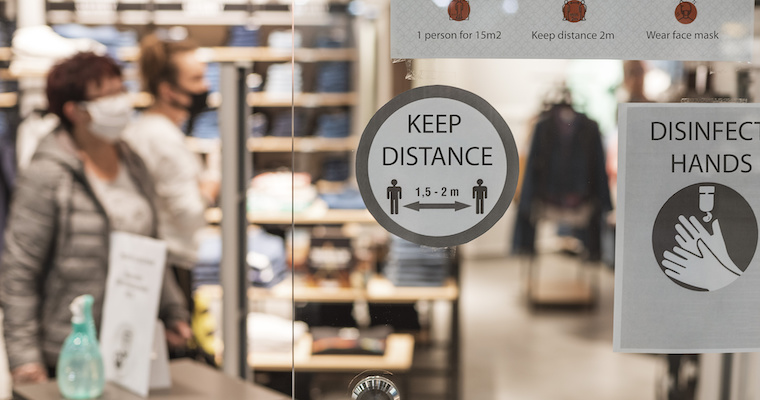Research Reveals How Business Families Have Coped With COVID-19

For this research, we surveyed over 1,000 family businesses around the world, with the objective to identify the most effective measures to cope with the COVID-19 pandemic. What sets our research apart from other surveys is that we focused both on the business and the family level. We find that what distinguishes this crisis from others on the business side is the increased focus on employee safety and well-being, and the need to critically evaluate and adjust existing business models. On the family side, shareholder groups experience more closeness due to increased (albeit virtual) interaction, but they also face challenges in dealing with delayed or missing dividend payouts.
Managing the Business in Crisis Mode: Beyond the Obvious
At its core, the COVID pandemic is a crisis like any other – and requires similar and well-established crisis mitigation measures, such as immediately stopping all non-necessary spending and cash outflows. However, some things are different, and require a different response. We found the following issues to be particularly interesting.
Securing business continuity
To actively manage the crisis to secure business continuity, the companies in our sample focused on establishing agile crisis structures, engaging in countercyclical behavior, and pushing for courageous change.
I will only briefly touch on these dimensions, since these are very obvious crisis mitigation measures that any lasting business is already intimately familiar with. Popular measures among the companies in our sample included establishing a COVID-19 task force, assessing and adjusting the supply chain, managing financial resources, and implementing a process to systematically collect and analyze information from a wide variety of sources (e.g., public health experts, economists, government). They also said it was important to keep in touch with important stakeholders; this included keeping core constituencies like key clients, suppliers and financial providers informed and up to date about how the company was managing the crisis. Many companies reported engaging in countercyclical activities, such as investing heavily in digitalization projects and new technologies or investing in employee education during furloughs.
And while any crisis requires companies to reassess their current activities as well as their strategy, the COVID-19 pandemic brought on a digital push that forced many companies to radically redesign their business models.
Employee well-being and mental health
Given the nature of the current crisis, taking care of employees’ physical safety, as well as wellbeing and mental health, was paramount for the companies in our sample. Companies made sure that employees felt safe and taken care of. Measures included providing masks and sanitizing products to employees both at their workplace and for their homes; increasing cleaning within the facilities; putting up physical dividers in places where social distancing was not possible; and dividing their workforce into cohorts that operated independently,
Companies were also quick to resort to remote working where possible – and were usually generous in how they handled the unique challenges associated with remote working during a pandemic. While working from home, many employees had to juggle their regular workload and childcaring (and virtual schooling) responsibilities simultaneously. In many cases, this led to a heightened anxiety because of the blurred boundaries between the work and private domains. Companies responded by putting in place hotlines, where employees were able to talk to mental health experts; others regularly surveyed their employees to make sure their mental health needs are being met. Generally, companies reported a high level of generosity and flexibility in this situation. They found individual arrangements for working parents, and made sure employees’ remote workplaces were efficient (e.g., contributing towards internet costs, paying for a second monitor, a more comfortable office chair or desk, or allowing employees to take office furniture home).
Go Back, or Keep Going?
Our data indicate that organizations and individuals adhere to one of two underlying beliefs: that going back to the old normal is an option, or that it isn’t. This affects how the companies and families approach this crisis.
“Old normal” companies (and individuals) are eager to surpass the pandemic. Any crisis mitigation measure is deemed temporary and is regularly revisited. Such companies might try to get their employees back to the workplace as quickly as possible. They tend to think that the crisis will be over soon, and see no fundamental changes to their organization and the way things are done, to their industry, and the economy at large.
“New normal” companies, on the other hand, have already let go of the idea that returning to “before” is even an option. This approach is rooted in accepting a changed world and wanting to learn from the crisis rather than simply overcoming it. They are looking at the changes they have made over the past few months and making permanent those measures that have proven to be most effective. They survey their employees to find out about their ideal long-term workplace scenario: fully remote, face to face, or a hybrid solution. They are analyzing their current supply chains, running scenarios to identify the most effective sourcing, and building a resilient stream of supplies going forward.
Companies will likely lean towards old normal or new normal depending on factors such as their organizational values and culture and their general openness to change. And while both approaches are valid – because who can predict anything with certainty this year? – something can be said about the “old normal” approach. A German phrase, which loosely translates to “hardship upfront,” says that if we know that change has to happen, a swift and strong response is better than incremental changes to achieve a certain outcome. In the context of the pandemic, it means that companies that favor incremental over radical change (i.e., letting 20 employees go in June, 35 in July, 47 in August, or continuously cutting benefits) because they are reluctant to make drastic and painful changes might lose credibility with their constituencies (“What will come next? Are they being honest with us?”). A swift response – with adequate mitigation measures to handle the consequences, in alignment with the company’s values and traditions – portrays the company as transparent and honest, and allows constituencies to retain trust.
Effectively Managing the Family Shareholder Group
Family alignment and cohesion are paramount to overcoming any crisis. If the shareholder group remains united and committed to the commonly shared purpose, they remain able to make decisions, and thus remain actionable even under pressure.
Many families reported having significantly more interactions (albeit virtual) with individual family members as well as the family shareholder group as a whole during this pandemic. Most families have never talked more than in recent months, which is why family members feel closer to one another. And based on this experience, many families are eager to continue on this path of increased communication and exchange, rather than resorting to previous levels of interaction. Members of the younger generation and non-operational shareholders particularly benefitted from this sudden inclusion in frequent conversations about the business’ future, which strengthened their commitment to the family and the business.
In this context, a key area of family longevity relates to how well-equipped family members, and in particular the next generation, are to perform their various roles in the family and the business effectively. Making systematic ownership competence development a strategic family priority, and dedicating adequate funding to make sure your family members are competent, responsible owners, are key characteristics of successful multigenerational families. This is a great time to begin thinking about such a program, and to discuss the next generation’s educational and self-development needs in settings like family meetings, a family assembly or the family council.
Many families have experienced serious conflict around how the pandemic is affecting dividend payments. In the face of a looming recession, many deemed it risky to distribute capital that might be needed in the future. Furthermore, those companies that cut salaries across the board found it challenging to justify dividend payouts. This remains a serious issue for business families whose members rely on dividend payments as a key source of income. Families should regularly revisit their family financial goals in relationship with the business. As the family grows exponentially, the business cannot keep up with the financial needs of the shareholders. The family sets itself up for failure if they don’t adjust the dividend policy to the changing reality of the family, or set up other ways to remunerate family members if a crisis prevents dividend payouts.
On the other hand, conflicts related to postponed or cancelled dividend payouts might also reflect either a lack of emotional commitment to the business, or a lack of understanding of how the business operates (these two are likely related). Families experiencing this issue might consider shareholder education and measures to strengthen family cohesion.
Best Practices and the Principle of Family-Practice Fit
Lastly, a word on “best practices.” These are procedures generally accepted as being the most effective, and are popular in the consulting realm and in scientific literature. Best practices aim to turn our anecdotal or empirically based findings into meaningful and actionable recommendations (or prescriptive practices) for practitioners.
Despite the good intentions behind making our survey findings and our experience available and accessible to others, the lack of context inherent in most best practices can lead to serious problems. Too often, what is being marketed as best practice in the family business realm – particularly when it comes to issues that affect the business owning family, such as governance practices – does not adequately consider the context in which the practice was implemented.
Take, for example, an employment policy that defines who can and cannot work in the company, and under what circumstances, or shareholder agreements that define the terms under which shares can be bought, sold, or transferred. Families with high levels of cohesion and trust generally benefit from a more inclusive policies (e.g., allowing spouses to work in the business, or allowing for a relatively free transfer of shares across branches and generations) because they are well capable of communicating effectively, and of resolving conflict. Inclusive policies allow such families to harness the benefits of family ownership by tying more committed family members to the business and the family.
However, for families with trust issues, or families that lack cohesion, highly inclusive policies would likely exacerbate existing conflicts or start new ones. These family systems are simply not equipped to deal with the communication and conflict management demands of such policies and will be unable to provide the level of trust to implement them.
In simpler terms: What might work for one family may be harmful for another. So we should not make broad prescriptions for all business families unless we can show the underlying circumstances that made that best practice successful: for example, the family’s ability to communicate effectively, resolve conflict constructively, and remain aligned, unified and actionable under pressure. The alignment between any practice, and the family’s needs, goals, and abilities, determines whether a practice will ultimately benefit a family, have no impact or even harm it. We call this principle the Family-Practice Fit.
One last thing to consider in the context of our global COVID survey is the fact that only time can tell if any practice or policy is indeed “good” (or even best), or merely common, or possibly even flawed. Unless we systematically monitor that practice or policy over time, we cannot determine its value for its constituencies. Hence, any prescriptive recommendations based on cross-sectional research (which means, data collected at a single point in time) are to be taken with a grain of salt. Only time will tell which measures were innovative or effective, or whether a measure to mitigate the pandemic’s effect will pay off long-term or cause problems down the road.
In summary, best practices can be powerful catalysts for positive change, but they should always be taken with a grain of salt. That is why, for now, we refer to the crisis management measures we identified through our research not as best practices, but as effective measures.
Closing Thoughts
In many ways, any crisis acts like a proving ground. A crisis will only exacerbate any tears in the fabric of the family or the business. We can't expect individual family members to make sacrifices for the greater good if the family lacks alignment, if individual interests are prioritized over the collective goals and the collective wellbeing, and if no compelling goal unites the family. Investing in family alignment and cohesion has never been more important.
The foundation of family alignment and family cohesion is relationship quality, and relationship quality is a direct outcome of the efficacy of our communication, and the positive intentionality of our interactions. It’s more important than ever to keep the family and other stakeholders engaged, and to keep talking with them and making them feel included. In crisis situations, there is no communicating too much – only too little.
And keep this in mind: While we pretend otherwise, we often listen with the intent to reply, rather than understand. But it is the listening with the intent to understand that makes people feel heard, and emotionally connected. Without an authentic emotional connection, it will be difficult to secure the family members’ commitment in times where they are expected to make painful sacrifices for the benefit of others, and the well-being and continuity of the group.

Head of Governance Practice at Generation 6 | Family Enterprise Advisors / Lucerne School of Business / Affiliated Researcher at Jönköping University (CeFEO) and Witten/Herdecke University
View Profile





